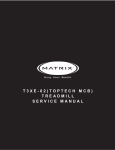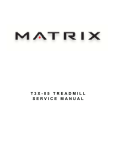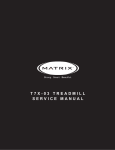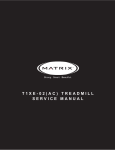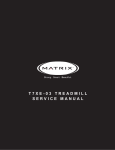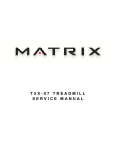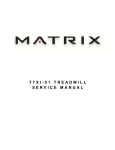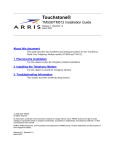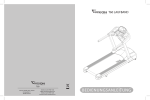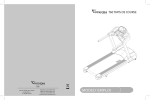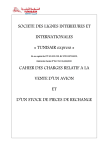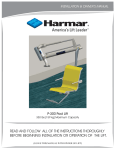Download Johnson T7000 Pro Service Manual
Transcript
Johnson T7000 Pro Service Manual 1 TABLE OF CONTENTS SECTION 7: WHAT’S DIFFERENCE BETWEEN T7000 AND T7OOOPro…………………………………….....……4 1. 2. 3. 4. T7000 Pro vsT7000 outlook design change……………………...……...5 T7000 Pro vsT7000 internal design change…………………..…………6 T7000 Pro vsT7000 console mast design change………………………7 T7000 Pro vsT7000 tension wheel set design change…..….………….8 SECTION 2: MAINTENANCE PROCEDURE …………..…….…9 1. 2. 3. 4. MAINTENANCE CHECK LIST………………………………...................10 TENSIONING THE BELT PROCEDURE…………………………….11-12 DECK RE-WAXING PROCEDURE……………………..……………13-14 CLEAN THE GROOVES PROCEDURE…………….............................15 SECTION 3: WIRING DIAGRAM INSTRUCTION………………..16 1. 2. 3. 4. T7000 Pro(TM512) MCB WIRING(FOR 110V / 220V)……………….17 T7000 Pro(TM512) MCB WIRING DEFINITION OF PIN……………..18 T7000 Pro(TM512) PCB WIRING………………………..……………..19 T7000 Pro(TM512) ELECTRICAL BLOCK DIAGRAM …………....…20 SECTION 4: CONSOLE FUNCTIONAL FLOW DIAGRAM……21 1. OPERATION T7000 Pro MANUAL…………………………………….22-26 2. OPERATION T7000 Pro MANUAL- Engineer mode………………...27 2-1 Key Behalf Functions………………………………………………….28-30 SECTION 5: MCB LED INSTRUCTIONS……………… ……….31 1. T7000 Pro MCB LED PLACE AND DEFINITION…………………….32 2 TABLE OF CONTENTS SECTION 6: TROUBLESHOOTINGS……………..……………33 1. 2. 3. 4. 5. 6. 7. No display on console…………………………………………………...34 Running speed is not stable…………………………………………….35 Treadmill starts to run by itself………………………………………….36 All or some of the keys on console do not work………………………36 Noises generated under motor cover………………...…………….….37 Error Messages on the Console………………………………………..38 How to make sure whether the machine hand pulse can not work…..39-40 SECTION 7: PARTS REPLACEMENT GUIDE…………..….…41 7.1 7.2 7.3 7.4 7.5 7.6 7.7 7.8 7.9 7.10 7.11 7.12 7.13 7.14 7.15 Front Plastic Shroud Removal …………………………………………42 Rear Roller Replacement……………………………………………….43 Side Rail Replacement………………………………………………….44 Front Roller Replacement………………………………………………45 Deck Removal……………………………………………………………46 Running Belt Removal ………………………………………………….47 Deck Cushion Replacement …………………………………………...48 Motor Control Board (MCB) Replacement …………………………...49 Motor Replacement……………………………………………………..50 Drive Belt Replacement ………………………………………………..51 Incline Motor Replacement …………………………………………….52 Console Control Board Replacement ………………………………...53 Console Cable Replacement ………………………………………….54 Emergency Stop Switch Replacement ……………………………….55 Heart Rate Board Replacement ………………………………………56 3 SECTION 1 What’s difference between T7000 and 7OOOPro 4 T7000 Pro vsT7000 outlook design change New design upper overlay Hand pulse set has been improved to one piece style. Motor sticker has modified the material to POLY The console mast has been modified to straight The frame sticker has modified to T7000 Pro 5 T7000 Pro vsT7000 internal design change Power system has been modified from DC to AC system Canceled the speed sensor New design tension wheel set New running belt with wax New running deck without wax. New belt spec. 250J12 The flat type front roller New design donut cushion Increase the bearing size 6 of front and back roller T7000 Pro vsT7000 console mast design change T7000 T7000 Pro New fix bracket Console mast in straight type 7 T7000 Pro vsT7000 tension wheel set design change T7000 Pro vsT7000 roller set design change Flat type pulley and increase bearing size 8 SECTION 2 MAINTENANCE PROCEDURE 9 MAINTENANCE CHECK LIST PREVENTIVE MAINTENANCE SCHEDULE Johnson T7000 Pro TREADMILL Item Daily Weekly Monthly Quarterly Console Mounting Bolts Frame Biannual Inspect Clean Inspect Inspect Power Cord Display Console Clean Handrail & Handlebar Clean Inspect Inspect Front Roller Clean Inspect Rear Roller Clean Inspect Clean Inspect Emergency Button Running belt Tension Test Inspect V Belt Running Deck Inspect Re-waxing Running Belt Inspect Control Box Clean (Vacuum) Motor Annual Flip Clean 10 TENSIONING THE BELT PROCEDURE Frequency: Every 1 months Caution: Over-tightening of the roller will severely shorten the life of the belt and may cause further damage to other components. Running Belt: If when you plant your foot on the belt, you can feel a slipping sensation then the belt has stretched and is slipping across the rollers. This is a normal and common adjustment on a new treadmill. To eliminate this slipping, tension both the rear rollers Allen bolts 1/4 TURN as shown above. Try the treadmill again to check for slipping. Repeat if necessary, but NEVER TURN the roller bolts more than 1/4 turn at a time. Perfect Tension of Running Belt: 0.9~1.1 lbs 11 Drive Belt: If you have tensioned the running belt and are still experiencing a slipping, adjust the tension screw of spring. Then try the treadmill again to check for slipping. 12 DECK RE-WAXING PROCEDURE Purpose : To ensure the maximum life of your treadmill, follow these steps at regular intervals. The timing of running belt and deck maintenance : 1. Each 6 months to lubricate by wax powder. 2. One year to flip the running deck. 3. Two years or over 6,000 hrs of usage to replace new running belt and deck. 4. In the regular maintain, If the motor over current that has to lubricate by wax powder ★ Take a motor current reading while a 70-90 kg user is walking on the machine at 5KM. If it is over limited current , wax the deck. The limit current for each motor as below : Motor type Normal Current Limited Current 220V DC <9A 11A 110V DC <15A 20A <5A 5.5A 220V AC 110V AC Recheck the motor current as above – If the motor current is still over limited current, Please flip the deck or replace the belt. 13 WAXING PROCEDURE: 1. Warm deck and belt by walking on treadmill for 3 or more minutes at a minimum speed of 3 mph (4.8 kph). 2. Turn off and unplug the treadmill. 3. Sprinkle approximately 1/2 scales of wax under the running belt. (It is useful to lightly blow the wax to the center of the belt.) 4. Turn the unit on and walk the wax in for 3-4 minutes at 1 mph. Walk all over the belt to ensure smooth wax distribution. 5. Once wax is walked into the belt and deck repeat procedure for checking the motor current to ensure that the belt and deck are not to worn for wax to improve the friction. Be careful to monitor wax buildup on the rollers – too much wax can cause issues and technicians need to monitor the rollers if they continually wax units. MTOOL-052 1/2 scale for one machine per one time (around 5gm) The wax powder set Parts number : MTOOL-052 Price : US$ 30 Wax powder set including 1. One big bottle with 1kg wax powder 2. A small bottle for maintenance. 14 CLEAN THE GROOVES PROCEDURE Frequency: Every 3 months Caution: If dirty grooves in the drive belt and motor, there will be noises while running. Procedure: 1.Remove the drive belt and check the grooves in belt for dirt or dust and clean it. 2.Check the grooves in motor pulley for dirt or dust and clean it 15 SECTION 3 WIRING DIAGRAM INSTRUCTION 16 T7000 Pro(TM512) MCB WIRING JP3 JP4 N L U V W W------- Motor wire (black) JP3--------Console cable V-------- Motor wire (white) JP4------Elevation motor cable U-------- Motor wire (red) L-------- Power Input (black) N------- Power Input (white) 17 T7000 Pro(TM512) MCB WIRING DEFINITION OF PIN 1 2 3 4 5 6 JP4: Elevation cable(6pin/AMP-350762-4) Pin Name Definition 1 +VDC 2 Position 3 Ground /E driver Incline place signal test ground 4 UP driver Incline motor does move to up 5 DOWN driver Incline motor does move to down 6 COMMON Incline motor does turn on power Incline place signal test power Incline place signal 18 T7000 Pro(TM512) PCB WIRING(FOR 110V / 220V) J17 J6 J19 J5 For analogy system use only JP2 N J3 L U V J19------- Digital communication wire port J5--------- Hand Pulse receiver J6--------- inbuilt receive implement J17------- Emergency stop key W 19 T7000 Pro(TM512) Electrical block diagram 接機台 20 SECTION 4 CONSOLE FUNCTIONAL FLOW DIAGRAM 21 OPERATING T7000 Pro 22 23 24 25 26 T7000 Pro MANUAL- Engineer mode How to enter into the engineering mode? 1. Press & Hold both “ELEVATION ▼” and “SPEED ▼” at the same time for 3-5 sec. Then, the display will show “MANAGER MENU”. 2. Press the “SPEED ▲ or ▼" to select you want and press the “ENTER" key enter. Engineer mode setting 27 KEY BEHALF FUNCTION key name function UP To scroll through the list of setting DOWN To scroll through the list of setting FAST Add this show parameter of speed and elevation SLOW Decrease this show parameter of speed and elevation START To Store up the parameter NUMBER KEY Set the parameter ENTER Enter the function place RESET reset to sources Hold UP & FAST key for 3’s clean accumulate time and distance 28 THE LIST OF MANAGER’S CUSTOM SETTING CUSTOM SETTING DEFAULT MINIMUM MAXIMUM DESCRIPTION P0 MAXIMUM TIME 99 10 99 Maximum workout duration. P1 DEFAULT TIME 20 10 99 Default start time in all programs. P2 DEFAULT LEVEL 1 1 10 Default start level in all programs. P3 DEFAULT WEIGHT 68KG /150LB 34KG /75LB 159KG /350LB P4 DEFAULT AGE 30 10 99 P5 MAXIMUM SPEED 20 KPH /12 MPH P6 MAXIMUM INCLINE 15% P7 ACCUMULATED DISTANCE N/A N/A N/A Total distance on treadmill, not editable. TO RESET: Press and hold INCLINE DOWN and SPEED DOWN for 3-5 seconds. P8 ACCUMULATED TIME N/A N/A N/A Total distance on treadmill, not editable. TO RESET: Press and hold INCLINE DOWN and SPEED DOWN for 3-5 seconds. P9 START SPEED 0.8 KPH / 0.5 MPH 0.8 KPH / 0.5 MPH 3.0 KPH / 1.8 MPH Controls the starting speed for all programs (does not affect minimum speeds). P10 PAUSE TIME 60 sec 30 sec 180 sec Controls the maximum time the treadmill can be paused during a workout. P11 LANGUAGE English N/A N/A Sets the language shown on the console. P12 UCB SOFT. VER. N/A N/A N/A Software Version of UCB, not editable. P13 MCB SOFT. VER. N/A N/A N/A Software Version of MCB, not editable. P14 UNITS Metric N/A N/A Measurement unit used for calorie calculations, distance, and speed. 6.4 KPH / 4.0 MPH 20 KPH / 12.0 MPH 4% , 8% , 12% , 15% (CONTINUE) Default weight used in calorie calculations and HR programs. Default age used in HR programs. Controls the maximum speed for all programs. Controls the maximum incline for all programs. 29 THE LIST OF MANAGER’S CUSTOM SETTING CUSTOM SETTING DEFAULT MINIMUM MAXIMUM DESCRIPTION P15 MAINTEN. REMINDER ON N/A N/A Controls the distance accumulative to maintenance. If default ON will can to select goal distance accumulative. 4000~8000KM , 2500~5000 Mile. P16 AUTO CHECK N/A N/A N/A This function is to calibrate the treadmill incline. P17 ERROR LOG N/A N/A N/A This function is to record the error occur history. P18 RESET ALL N/A N/A N/A This function is to reset all parameter. P19 MANUFATURING TEST N/A N/A N/A For factory use only. Remarks If you on P19: MANUFACTURING TEST this ADDRESS place, you can hold the number key “1 and 3” for 3’s enter MANUFACTURING TEST . ADDRESS description M0 TEST M1 Low speed M2 High speed M3 RPM Parameter 30 SECTION 5 T7000 Pro MCB LED INSTRUCTIONS 31 T7000 Pro MCB LED PLACE AND DEFINITION PWM------ Console PWM signal light (when motor running the light should be flash) COM------ Digital communication light Fault------ The machine is stopped cause any C class errors Up / Down (FF)------ Elevation motor status light 32 SECTION 6 TROUBLESHOOTINGS 33 No display on console Possible causes: 1. Breaker is damaged. 2. ON/OFF switch is damaged. 3. MCB is damaged 4. Digital communication cable is damaged 5. PCB is damaged Fix: 1. Inspect the circuit breaker to see if it has tripped off. (If it is tripped off….like diagram B, reset the breaker. And check which part is short-circuited. Then replace the short-circuited part.) A B 2. The switch is turned to the "ON" position. ( If the switch light isn't lit, replace the switch.) 2-1 Verify wire connection N & L on the MCB. (Please refer the” MCB WIRING” ……page 17) 3. Verify the MCB whether supply the +12VDC for console. 4. Replace digital communication cable . 5. Replace PCB 34 Running speed is not stable Possible causes: 1. AC power voltage is too low. 2. Tension of drive belt or running belt is too loose. 3. MCB is damaged. 4. Motor is damaged. Fix: 1. Check the power voltage by using voltage-meter to see if it is within 120V±15% or 230V±15%. If the power voltage isn't within the range, look for a qualified electrician for help. 2. Open the motor cover, if the belt has stretched and is slipping across the rollers when running. Adjust the belt tension (Please refer the” TENSIONING THE BELT PROCEDURE”……. Page11~12). 2. Replace new MCB. 3. Replace new Motor. 35 Treadmill starts to run by itself Possible causes: 1. The digital communication cable is broken. 2. PCB is out of order. 3. MCB is out of order. Fix: 1. Replace the console cable with a new one. 2. Replace the PCB. 3. Replace the MCB. All or some of the keys on console do not work Possible causes: 1. Keypad connecting plug is not fit-in properly. 2. Keypad is damaged. 3. PCB is damaged. Fix: 1. Disconnect the keypad and replace the keypad, and check again. 2. Replace the keypad. 3. Replace the PCB. 36 Noises generated under motor cover Possible causes: 1. The running belt tension is adjusted too tight. 2. The bearing of front roller is not installed correctly. 3. Dirty grooves of drive belt. 4. The motor is damaged. Fix: 1. Adjust the belt tension so that the belt does not start slipping and then check if the noise has disappeared. Let the treadmill run, without using it, for at least 5 days because sometimes the bearing will settle and become quiet then check if the noise has disappeared. 2. 3. 4. Replace the front roller with a new one to see if the noise disappear. Remove drive-belt and check the grooves in belt for dirt or dust and clean if necessary. Clean also the motor pulley and the roller pulley grooves and check if the noise has disappeared. The motor bearing is damaged. Replace the motor. 37 Error Messages on the Console Class Level Error Code B 0140 C 01A0 C 01A4 C 01A5 C 01A6 C 01A8 C 01AB C 01AD C 02A0 C 02A1 C 02A2 C 02A8 C 02AD C 02B5 C 02B6 C 02B7 C 02B8 C 02B9 C 02BA C 02BC C 02BD Description Conditioned Solution when the elevation is supposed to move, it does 1. connection check not move. When the error happens, the elevation Incline motor operation fail. 2. MCB LED check will be locked. The command "initialize" is 3. incline motor check or replace needed to unlock the elevation. 1. connection check when the elevation position cable is not Incline motor disconnection 2. MCB LED check connected 3. incline motor check or replace Main motor U phase Main motor U phase disconnection 1. connection check U disconnection Main motor V phase Main motor V phase disconnection 2. connection check V disconnection Main motor W phase Main motor W phase disconnection 3. connection check W disconnection 1. connection check main motor over current main motor over current 7Amps 2. lubrication 3. overload 1. check MCB error by PU-01 Inverter Error internal error of inverter 2. MCB replacement Inner electron over when the user over 130kg to make motor over temperature : motor over Lubrication running belt loading and Inner electron over temperature loading. 1. connection check (power input ) the belt does not move when it supposes to main motor fail 2. motor resistance check move 3. MCB replacement Over AC power input check power input power input voltage over range voltage Over / low DC bus voltage power input voltage over range check power input Inverter circuit of motor 1. motor check or replace motor resistance close. driver fail 1. check MCB temp. by PU-01 LCB over temperature LCB over temperature 2. check cool fan 3. MCB replacement Inverter sensor the normal Inverter sensor the normal rated current over rated current over 150% , motor check or replace 10.5Amps , can hold 60 sec.) can hold 60 sec. Speed up have over Lubrication Software discover current. Speed down have over MCB replacement Software discover current. 1. connection check Running status over current. Software discover 2. lubrication 3. overload The inner memory IC data MCB replacement MCB fail write error The inner memory IC data MCB replacement MCB fail read error Ground connection or fuse MCB replacement MCB fail error Inverter hardware interrupt MCB replacement MCB fail error Class Level--Level--Class C : The machine will be stop. Class B : To make a record in error log only, The machine keep working. 38 How to make sure whether the machine hand pulse can not work 1. Please make sure then user hold the hand pulse whether windows show picture. Remark: Heart rate figure show up on the screen about in 5~10 sec. 2. If the heart rate figure still doesn't show up on the screen, Please inspect according to the step as below. Step 1: Using multi-meter to confirm the wire has conduct. 39 Step 2: Please check the connection. Check whether the heart rate cable is touching hand pulse metal (both of left hand and right hand). Besides the other side of the heart rate cable should be connected with HR board. Step 3: If you can't find any problem with above step, and the heart rate figure still can't show up, Please replace the heart rate board. 40 SECTION 7 Part Replacement Guide 7.1 Front Plastic Shroud Removal 7.2 Rear Roller Replacement 7.3 Side Rail Replacement 7.4 Front Roller Replacement 7.5 Deck Removal 7.6 Running Belt Removal 7.7 Deck Cushion Replacement 7.8 Motor Control Board (MCB) Replacement 7.9 Motor Replacement 7.10 Drive Belt Replacement 7.11 Incline Motor Replacement 7.12 Console Control Board Replacement 7.13 Console Cable Replacement 7.14 Emergency Stop Switch Replacement 7.15 Heart Rate Board Replacement 41 CHAPTER 7: Part Replacement Guide 7.1 Front Plastic Shroud Removal 1) Turn off the power and move the plug 2) Remove the eight fix screws of front shroud using a Phillips screwdriver (Figures A & B). 42 CHAPTER 7: Part Replacement Guide 7.2 Rear Roller Replacement 1) Turn off power and disconnect the cord from the machine. 2) Remove both side end caps using a Phillips screwdriver (Figure A). 3) Remove both roller adjustment screws using an 8 mm Allen wrench (Figure B). 4) Remove the roller from the running belt (Figures C). 5) Reverse Steps 1-4 to install a new roller A A C B 43 CHAPTER 7: Part Replacement Guide 7.3 Side Rail Replacement 1) Remove the front shroud as outlined in Section 7.1. 2) Remove the end cap using a Phillips screwdriver (Figure A). 3) Remove the end cap bracket using a 3 mm Allen wrench (Figure B). 4) Slide the rail off the back of the treadmill (Figures C). 5) Reverse Steps 1-4 to install a new side rail. A A B C 44 CHAPTER 7: Part Replacement Guide 7.4 Front Roller Replacement 1) Remove the front shroud as outlined in Section 7.1. 2) Release the tension of running belt 3) Remove the fix bolt of tension wheel set using a 5 mm Allen wrench (Figure A) Be careful to hold the tension wheel set when fix bolt is releasing. 4) Remove the fix bolts of front roller using a 5 mm Allen wrench (Figure B) 5) Remove the driver belt form front roller. (Figure C) 6) Remove the front roller from the running belt 7) Reverse Steps 1-6 to install a new roller A B C 45 CHAPTER 7: Part Replacement Guide 7.5 Deck Removal 1) Remove the front shroud as outlined in Section 7.1. 2) Remove the side rail as outlined in Section 7.3. 3) Remove the eight deck screws using a 5 mm Allen wrench (Figure A). 4) Loose the tension of running belt 5) Remove the deck from the running belt 6) Be careful not to pinch fingers during removal / installation of deck board. 46 CHAPTER 7: Part Replacement Guide 7.6 Running Belt Removal 1) Remove the front shrouds as outlined in Section 7.1. 2) Remove the rear roller as outlined in Section 7.2. 3) Remove the side rail as outlined in Section 7.3. 4) Remove the front roller as outlined in Section 7.4. 5) Remove the deck as outlined in Section 7.5 6) Remove the running belt and replace with a new belt 7) Reverse Steps 1-6 to install a new running belt. 47 CHAPTER 7: Part Replacement Guide 7.7 Deck Cushion Replacement 1) Remove the front shrouds as outlined in Section 7.1. 2) Remove the rear roller as outlined in Section 7.2. 3) Remove the side rail as outlined in Section 7.3.side rail as outlined in Section 7.3. 4) Remove the deck as outlined in Section 7.5. 5) Remove the running belt as outlined in Section 7.6 6) Remove the front roller as outlined in Section 7.4. 7) Holding the bolt with a 5 mm Allen wrench, loosen the nut with a 13 mm socket (Figure A & B). A B 48 CHAPTER 7: Part Replacement Guide 7.8 Motor Control Board (MCB) Replacement 1) Turn off power and disconnect the cord from the machine. 2) Remove the front shroud as outlined in Section 7.1. 3) Cut any wire ties that are secured to the MCB panel (Figure A, B). 4) Disconnect wires from the MCB - six total connections (Figure C). 5) Remove Four MCB mounting screws using a Phillips head screwdriver (Figures D). 6) Reverse Steps 1-5 to install a new MCB. 7) Auto Calibration must ALWAYS be run after replacing the MCB (see Section 3.2). A B C D 49 CHAPTER 7: Part Replacement Guide 7.9 Motor Replacement 1) Turn off power and disconnect the cord from the machine. 2) Remove the front shroud as outlined in Section 7.1. 3) Release the drive belt tensioner as outlined in Section 7.5. 4) Disconnect the motor power cable from the MCB (Figure A). 5) Using an 8 mm Allen wrench, remove the four motor mounting screws (Figure B). 6) Lift the motor away from the treadmill 7) Reverse Steps 1-6 to install a new motor. 8) When reinstalling the motor, make sure the vibration pad is in place. 9) Be careful the diversion when motor remove and reinstall. (Figure C) A B C 50 CHAPTER 7: Part Replacement Guide 7.10 Drive Belt Replacement 1) Remove the front shroud as outlined in Section 7.1. 2) Release the drive belt tension wheel set from drive belt as outlined in Section 7.4. 3) Remove the front roller screws on both side (Figure A). 4) Lift the roller and remove the old drive belt 5) After installing a new belt, check it for correct alignment to the motor pulley before setting the tension wheel set in place. A A 51 CHAPTER 7: Part Replacement Guide 7.11 Incline Motor Replacement 1) Turn off power and disconnect the cord from the machine. 2) Lift the treadmill and support it so that the front wheels are off the floor, or the unit may be tipped on its side (Figure A). 3) Disconnect the incline motor power cable from the MCB (Figure B). 4) Disconnect the bolt from the incline motor (Figure C). 5) Lift the incline motor away from the treadmill. 6) When installing the new incline motor, make sure to replace the white washers at the top and bottom. 7) Auto Calibration must ALWAYS be run after replacing the incline motor (see Section 3.2). A B B C C 52 CHAPTER 7: Part Replacement Guide 7.12 Console control board Replacement 1) Turn off power and disconnect the cord from the machine. 2) Remove the four 6 mm screws using a Phillips head screwdriver from underneath the console to open the upper console cover. (Figure A). 3) Disconnect all of the wires from the console control board. (Figure B). 4) Remove the seven fix screws of CCB using a Phillips head screwdriver. (Figure C). 5) Reverse Steps 1-4 to install a new console control board. 6) Auto Calibration must ALWAYS be run after replacing the console (see Section 3.2). A B C 53 CHAPTER 7: Part Replacement Guide 7.13 Console Cable Replacement 1) Turn off power and disconnect the cord from the machine. 2) Open the upper console cover as outlined in Section 7.12-2. 3) Disconnect the console wire from CCB (Figure A). 4) Connection the defect wire and new wire (Figure B). 5) Pull the defect wire from lower outlet of console mast. 6) Reconnect console wire to MCB and CCB. A B 54 CHAPTER 7: Part Replacement Guide 7.14 Emergency Stop Switch Replacement A 1) Turn off power and disconnect the cord from the machine. 2) Open the upper console cover as outlined in Section 7.12-2. 3) Use a Phillips screwdriver to remove two screws of the cover of Emergency key (Figure A). 4) Use a Phillips screwdriver to remove two screws of the base of Emergency key (Figure B). 5) Turn open the Emergency switch (Figure C). 6) Reverse Steps 1-5 to install a new Emergency key set B C 55 OK CHAPTER 7: Part Replacement Guide 7.15 Heart Rate Board Replacement 1) Turn off power and disconnect the cord from the machine. 2) Open the upper console cover as outlined in Section 7.12-2. 3) Disconnect the wires from each side of the Heart Rate Board (Figure A). 4) Use a Phillips screwdriver to remove two screws, one from each side of the Heart Rate Board mounting bracket (Figure B). 5) Be sure to fully seat the wires on the new Heart Rate Board and test the grips after the console is reinstalled. A A B 56
























































